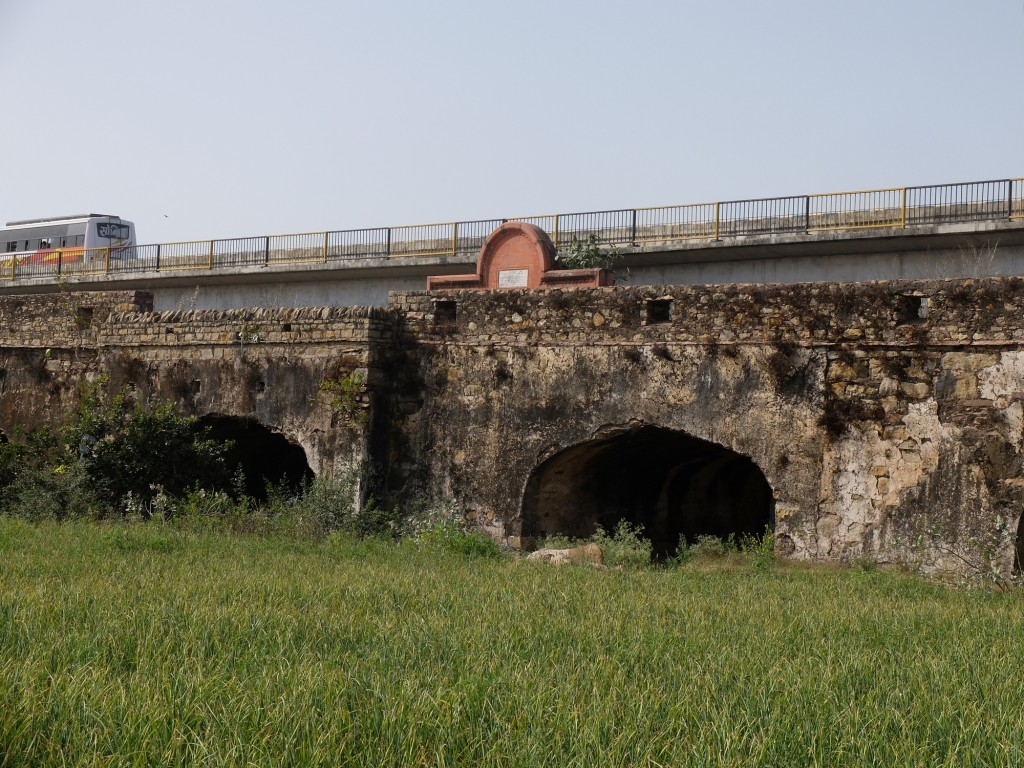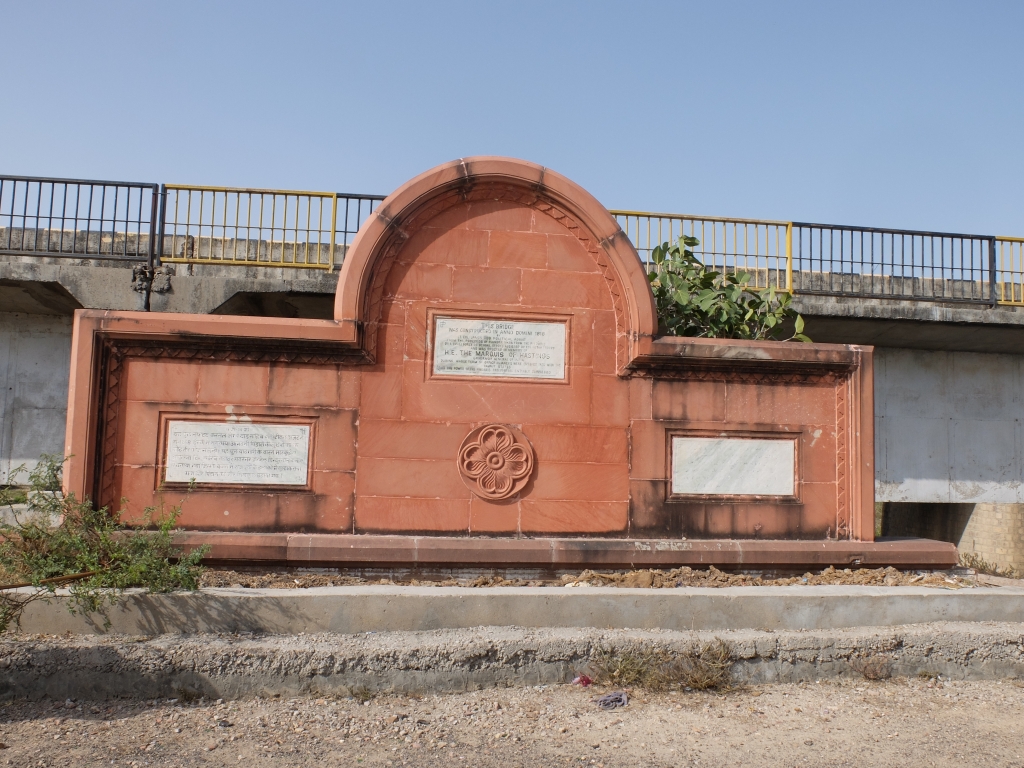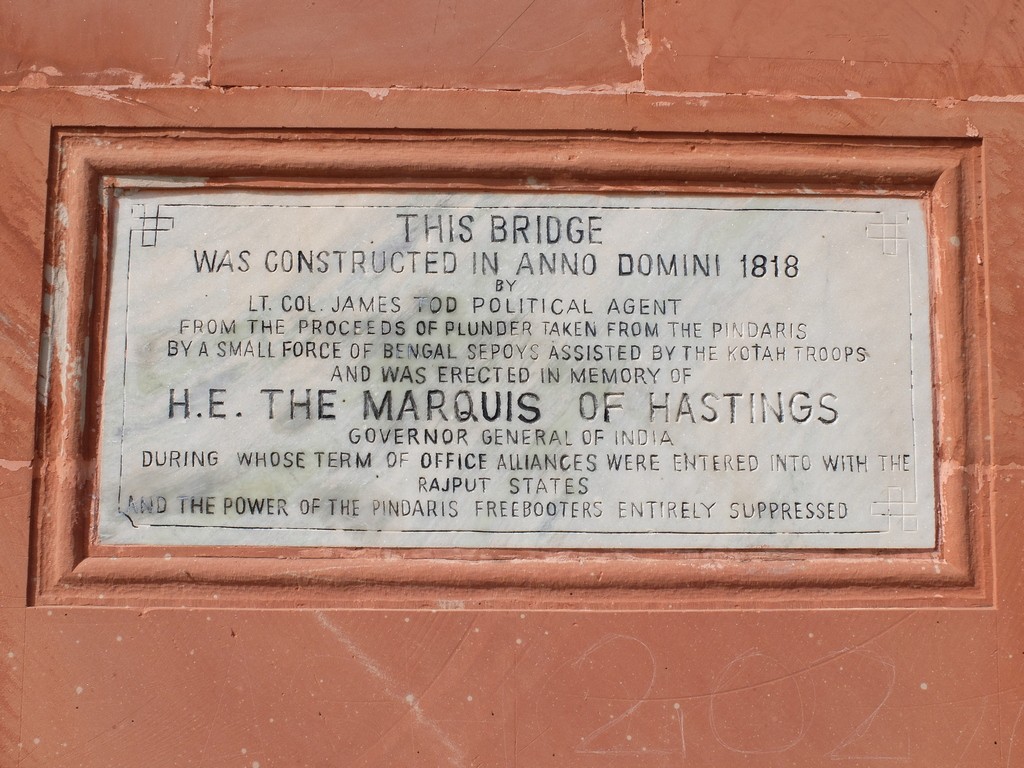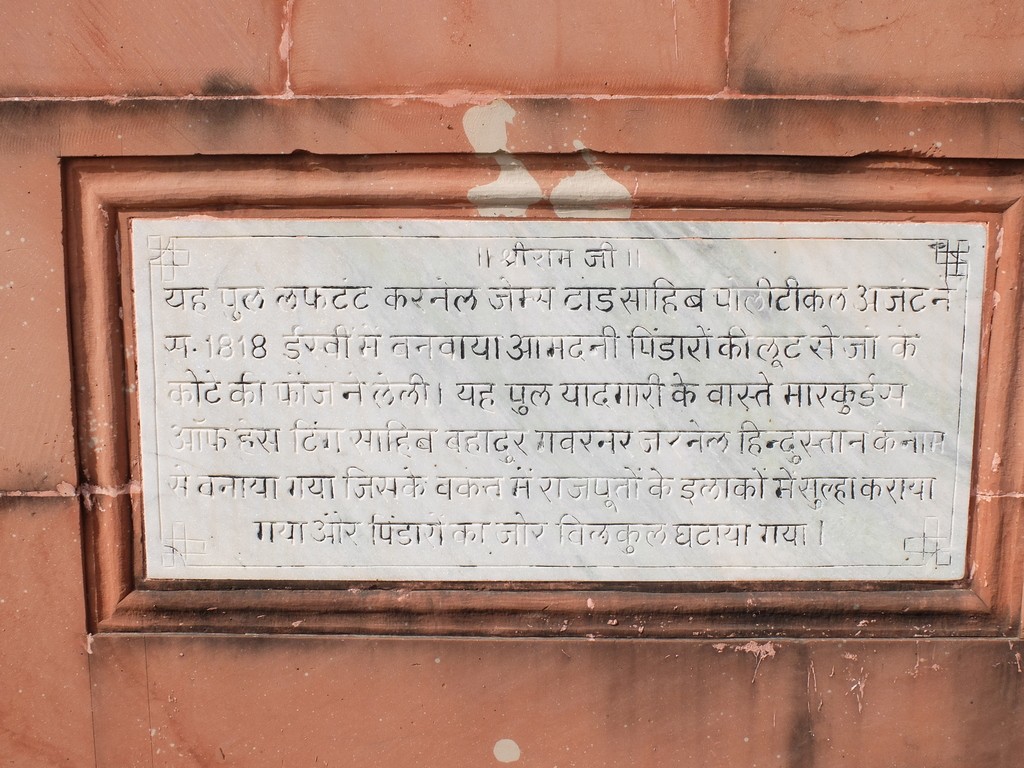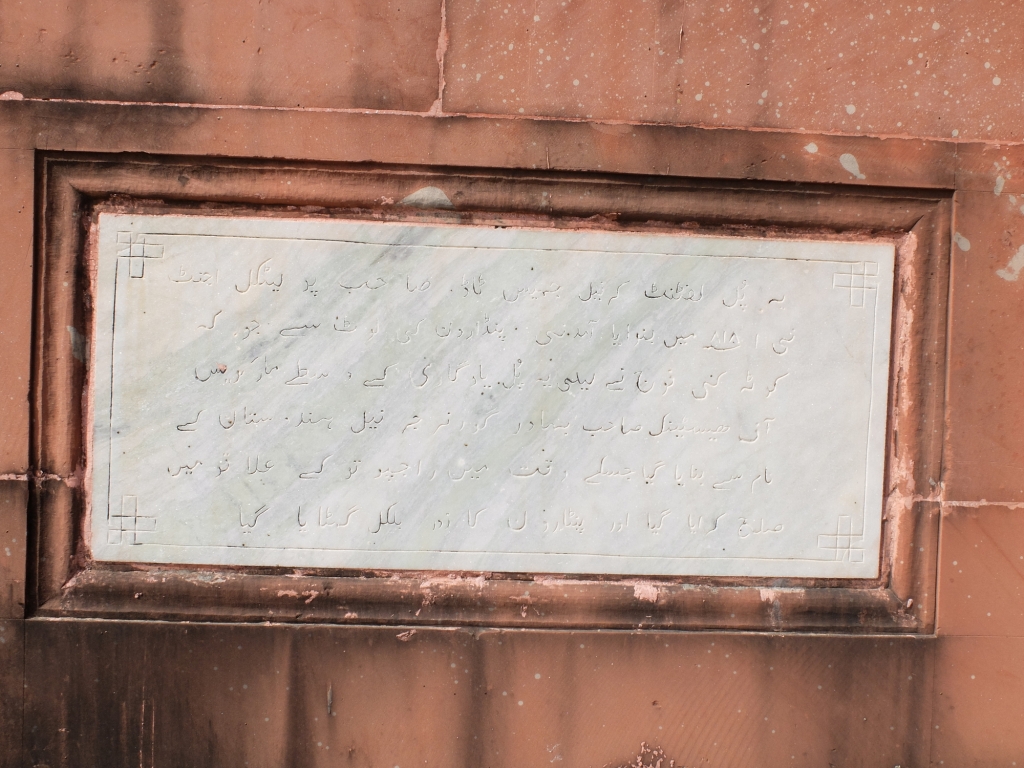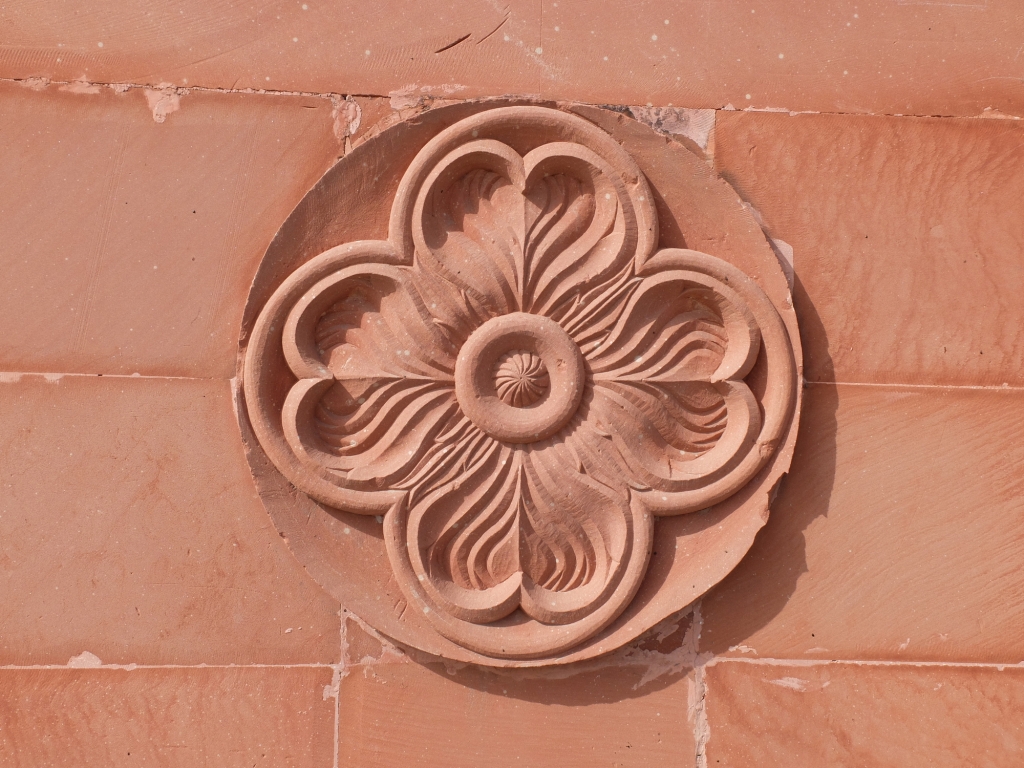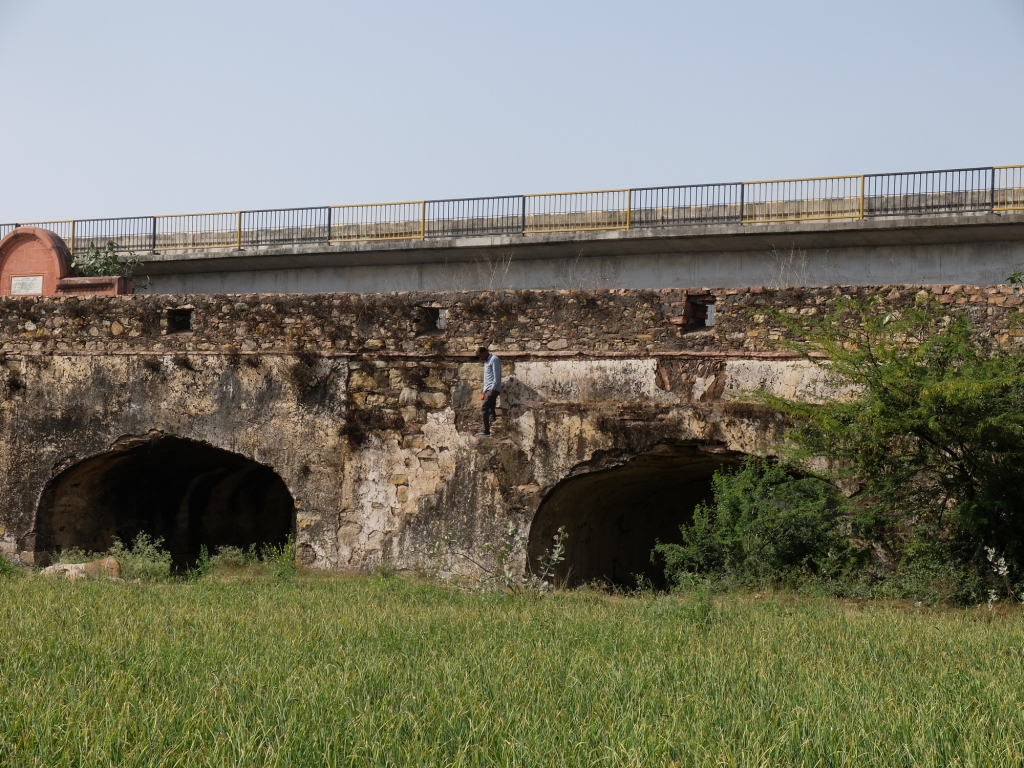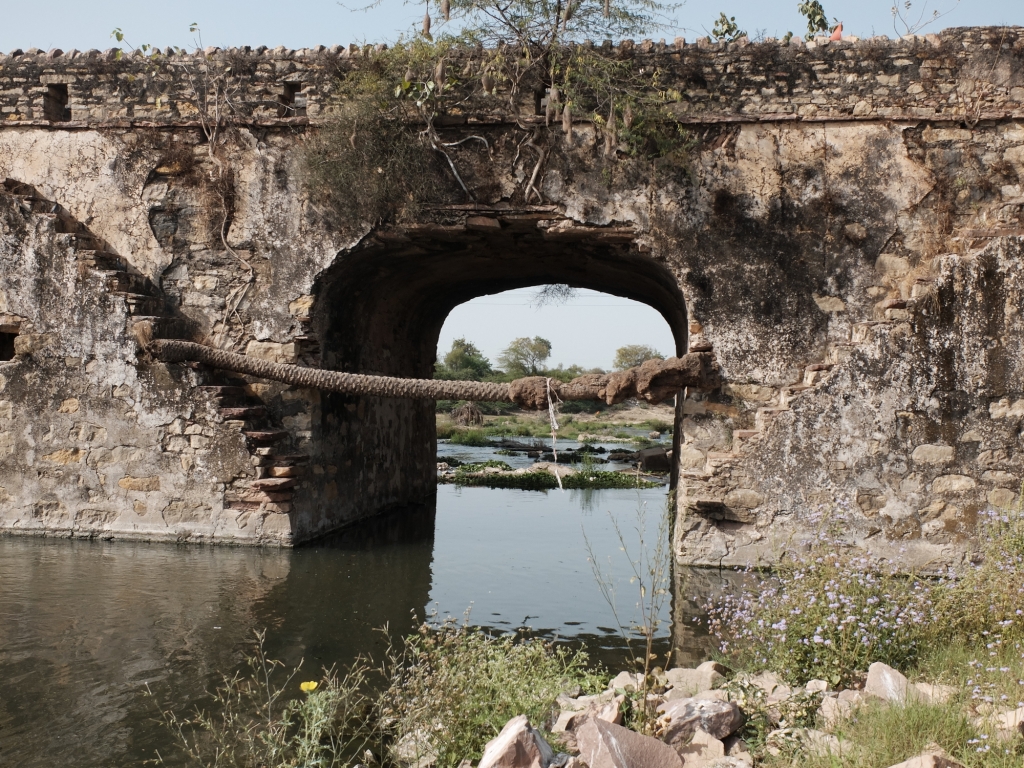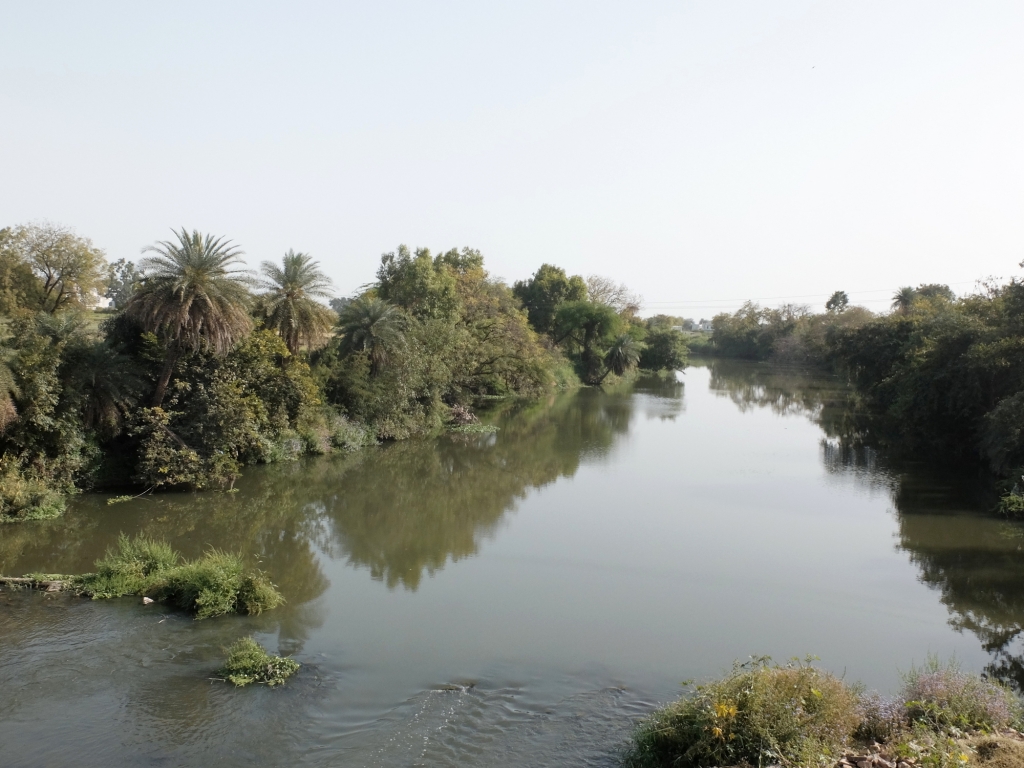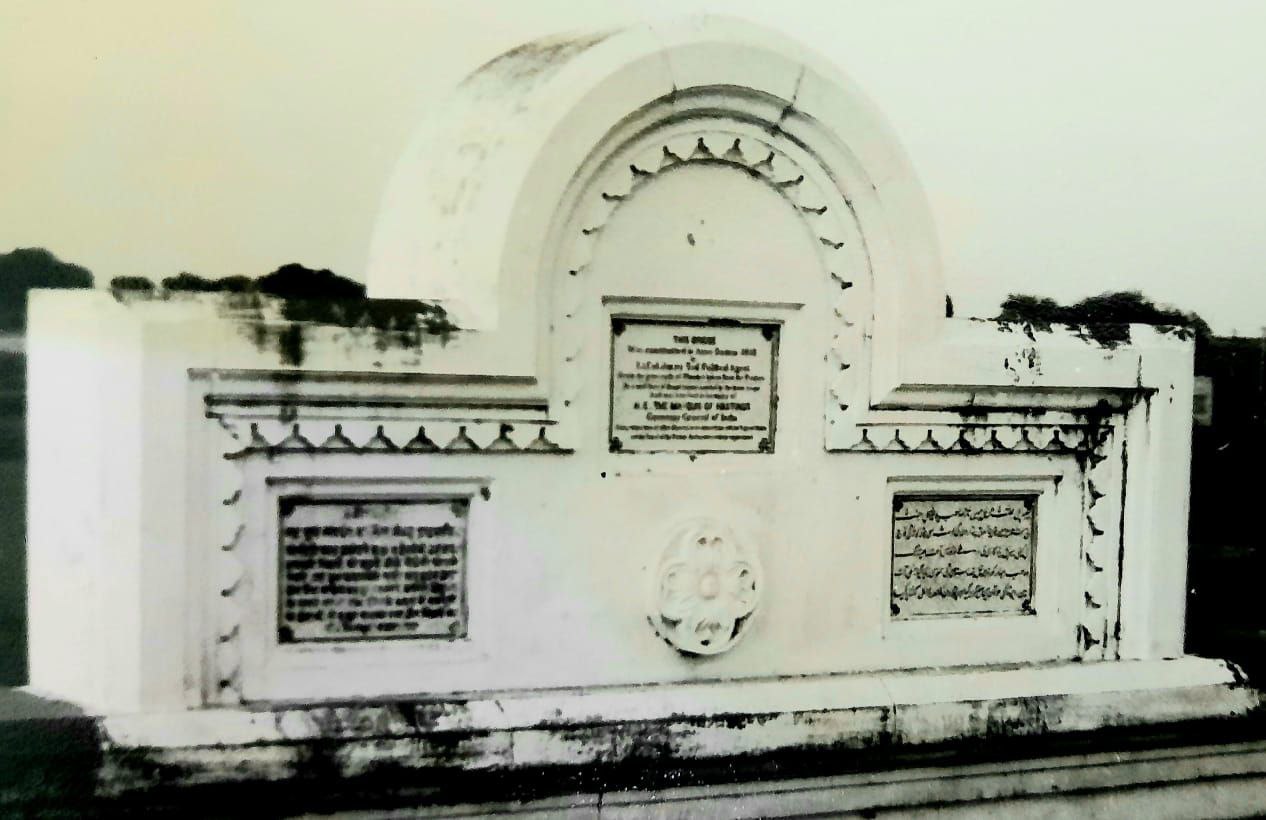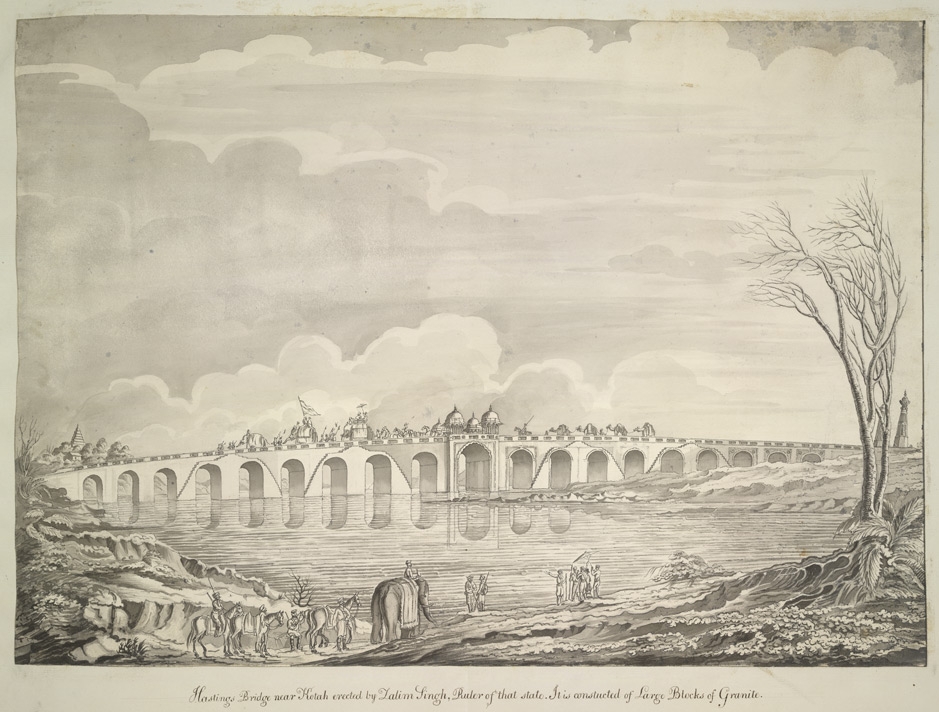Col. Sudhir Farm
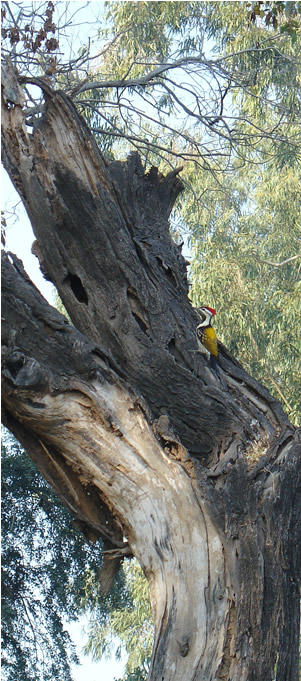
Snippets from the Visitors' Book
Our visit at the farm was truly wonderful, off the beaten track it is a slice of India a visitor does not normally experience. Victoria is very knowledgeable about Indian culture and the people - an added perspective for us. The food here was very delicious: organically home grown ingredients, vegetables, fruits, grains prepared simply homestyle. A nice change from curries. Enjoyed the early morning boat ride and walk to the weavers. Many thanks.
Johanna Janssens, Washington, USA

Memory Lane
A page devoted to recording memories which we hope you will view in the context of contemporaneous life.
Memories of a Young Englishwoman of India in the 1950’s
“Life in India in the 1950s was very special. I was privileged to have been a young girl in those days - life was so free and happy and everyone respected each other whatever their faith/nationality. Needless to say we all had a great social life - balls, parties etc. with the Indians, Brits, Canadians, Americans, Embassies etc. and the Navy, Army and Airforce - never a dull moment. We were invited to Mr Nehru’s home which was a great highlight and a great honour.
“I had a job with BOAC1. No need for a work permit in those days and no visas either!!!! My parents had the most wonderful 4 yrs. in Delhi. My father was Commander-in-Chief of the Indian Navy - they very often travelled all round India (flying with the Indian Airforce) visiting Naval Establishments. Cdr. Galpin, who ran the BOAC office, always let me off whenever I had the chance to travel with my parents, so I too saw a lot of India.
“I played tennis most afternoons/evenings at the Delhi Gymkhana Club. I was also regularly invited by Mr Nehru’s aides to play tennis with them on the PM’s courts followed by a very lavish tea/soft drinks - it truly was the most magical life. When my parents had visitors from abroad they would take them down to Agra by plane - the Taj Mahal in those days was so quiet with very few visitors.
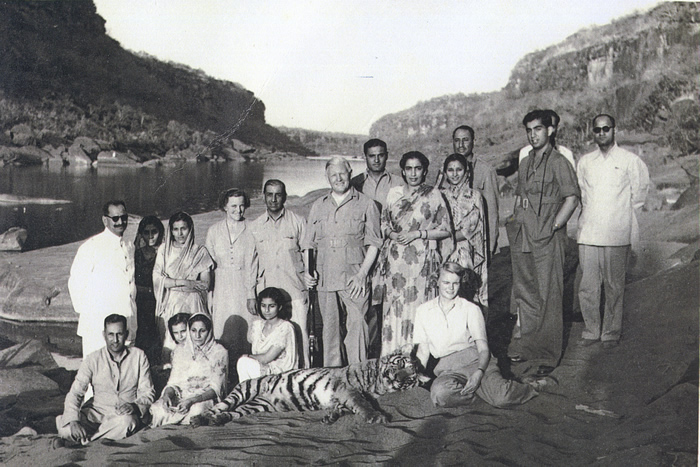
“We must have gone down to Kota by train. Trains had no aircon, just large slabs of ice in the corner of the compartment. We stayed at the Guest Palace2. The Kota family were wonderful. They took us round the Fort, museum, temples, the lake. The Tiger shoot that I went on was along the river3. We also sat up in trees at night and travelled through the forests on elephants.”
Pamela Hawkins daughter of the late Admiral Sir Mark and Lady Pizey. Sir Mark was the C-in-C of the Indian navy 1951-55.(Pamela is a cousin of a cousin). October 2008
Notes
1British Overseas Airways Corporation
2The Guest Palace was built as a Residence for the British Political Agents and is now the home of HH Brijraj Singh and a heritage hotel
3River Chambal - the only perennial river in Rajasthan
Who is Who in the Above Photograph
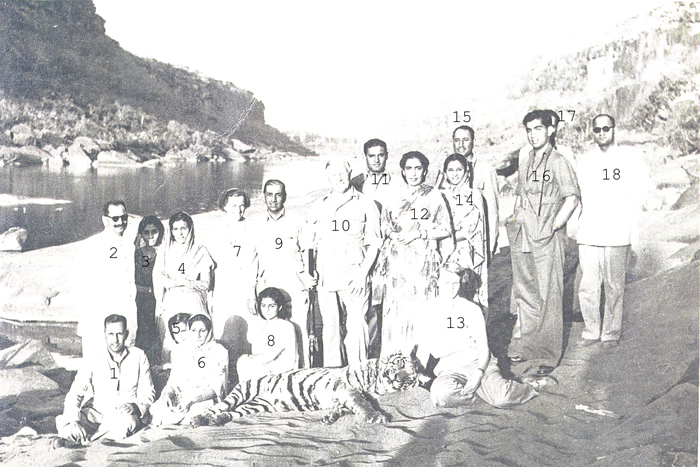
1 Brig. Apji Randhir Singhji (Koela)
2 Mr. Kaul
3
4 Ridhi Sidhi (Mrs. Raj Gajendra Singh, Kunadi)
5 Narendra Kanwar (Kunadi)
6 Subhadra Kumari (Mrs. Raj Gopal Singh, Kunadi)
7 Lady Phyllis Pizey
8 Suresh Kanwar (Bambolia)
9 Maharao Bhim Singhji II, His Highness of Kotah
10 Admiral Sir Mark Pizey D.S.O.R.N, Commander-in-Chief of the Indian Navy 1951-55
11 Flg. Lt. Dutta, ADC to the Admiral
12 Maharani Sahiba Shiv Kumari of Kotah
13 Pamela Hawkins, daughter of Admiral Pizey
14 Mrs. Randhir Singhji (Koela)
15 Kalyan Singhji (Koela)
16 Maharaj Kumar Brijraj Singhji of Kotah
17 Jujharh Singhji (Kundanpur)
18
The Quit India Disturbances in Kota 1942
On August 9th 1942, Mahatma Gandhi called for peaceful demonstrations against British Rule. This was the birth of the Quit India Movement.
In Kotah the 33 year old ruler, H.H. Maharao Bhim Singhji, had succeeded to the throne just two years earlier. He was sympathetic to the movement and allowed the demonstrations to take place as they were not threatening law and order and were not aimed at his rule. At first the daily demonstrations were held on the open ground opposite the Crosthwaite Institute, now Umed Club.
The British appointed Prime Minister of Kotah State was Sir Hari Lal Gosalia (ICS) from Gujerat, and the Inspector General of Police, Sadar Sant Singh was from the Punjab, and they both saw things differently as outsiders. As the demonstrators, led by well known lawyers and socialists marched into Rampura Bazaar in the old city and surrounded the main police station or Kotwali, they demanded action. The demonstrators after cutting the telegraph wires and shutting the city gates, began throwing stones at the Kotwali. The Prime Minister ordered the GOC to call out the Army. The 1st Umed Infantry was in Karachi at that time and only the 2nd Brijraj Trg. Batallion was in Kotah. The PM intended the Army to fire on the crowd. Col. Th. Prithi Singh1, GOC, Kotah State Forces clearly refused and is reputed to have said: "Sh**! I shall not do so!! I will get orders from my Ruler - not you!" He went to His Highness, who fully agreed with his decision. So the Army was not called out.
Kotah was a feudal Princely State and the relationship of the king to his people was paternal. H.H. Bhim Singhji was appalled at the situation developing and the likelihood of his subjects being fired at. He summoned the former Diwan (Prime Minister) Apji Sir Onkar Singh of Palaitha2 and ordered him to go and talk to the demonstrators. Sir Onkar requested that a pistol from the armoury be provided to him. Accompanied by HH's faithful gun-bearer Th. Anar Singh and Apji Kalyan Singh Koela, ADC, he set out on his mission in an open two horse buggy. The city gates3 had already been closed by the demonstrators. However, when they recognized their former Diwan the small gate in the main gate was opened and he was allowed through. He walked up to the Kotwali where the people greeted him respectfully and touched his feet. They demanded the removal of the PM and the IGP. Sir Onkar advised that that might not be possible as they were British appointees but he would convey their feelings to H.H. He did, however, order the police on the spot to leave and allowed the crowd to hoist the tri-colour, known as the freedom flag, over the Kotwali. This was enough to diffuse the situation.
Since his Highness had been able to control the disturbances so easily, PM Gosalia assumed that he was in league with the demonstrators and had instigated the trouble in the first place. He wrote to the Viceroy, Lord Linlithgow, lodging a formal complaint against H.H. Maharao Bhim Singhji and asking that he be removed from the Gaddi (throne).
In order to forestall the mischief set afoot by the wily Gosalia, H.H. spoke to his father-in-law, H.H. Maharaja Sir Ganga Singhji of Bikaner who was a great figure amongst the Princes and who had close relations with the Royal Family of England, the Viceroy and the British in India.
H.H. Bikaner, although very ill with cancer at his residence in Bombay, acted swiftly and on his strong representation to the Viceroy was instrumental in negating the entire devious intrigue by, both, the PM and the IGP. H.H. Bhim Singh, with the Viceroy’s support, was able to turn the tables on the plotters. Although ill with malaria at the time, he summoned the unsuspecting PM Gosalia to Umed Bhavan and in his office bereted him and had a showdown. Gosalia was relieved of his post on the spot. He left the same afternoon by the Frontier Mail for Bombay. As news of his dismissal was keenly awaited by the Congress agitators, word leaked that he was "Out." They gathered at the Kotah Railway junction with garlands of shoes. The ex-PM saved himself this final indignity by getting the train to stop for him for 5 minutes at the Kota City station near Police Lines. The IGP was also dismissed.
(With thanks to H.H. Brijraj Singh, Jujharh Singhji (former ADC in 1942), and Shivraj Singh Palaitha grandson of Sir Onkar Singhji.)
Notes
1Thakur Prithi Singh lived at Sukhdham which was built for the British surgeon in 1870. It is now run as a hotel.2Sir Onkar Singh lived in Palaitha House in Mokhapara in the Old City. In his retirement a state buggy was placed at his service every morning.
3There were gates near Koela House which were removed when the road around the lake was made.
A Flying Boat Visits Kotah c1937
This series of amazing photographs was taken, probably in the year 1937, by Raj Chandra Sen of Kunadi - a keen photographer. One would be hard put to find comparable photographs of this aircraft! And they have a story to tell. The photographs record an 18-hour stopover at Kotah on the River Chambal for repairs. The fortification walls of Kotah, and the Palace within, make for a dramatic backdrop. What must have gone through the minds of the crowds of people who gathered to watch this other worldly contraption, as they would have never seen, or imagined, anything like it!
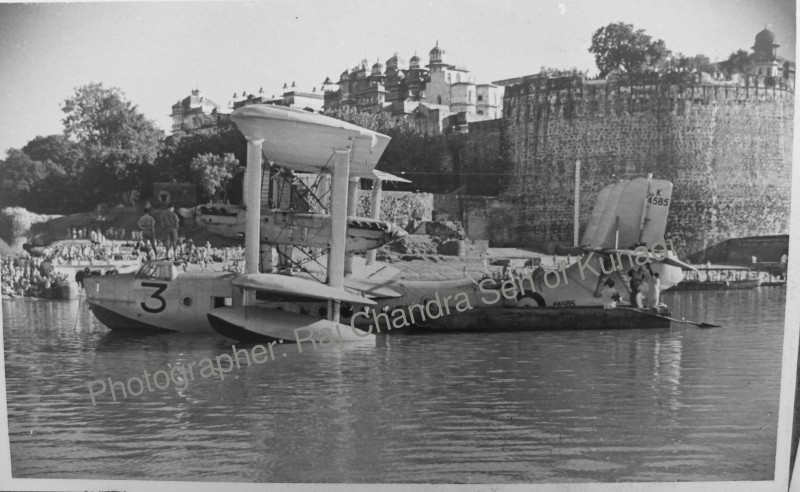
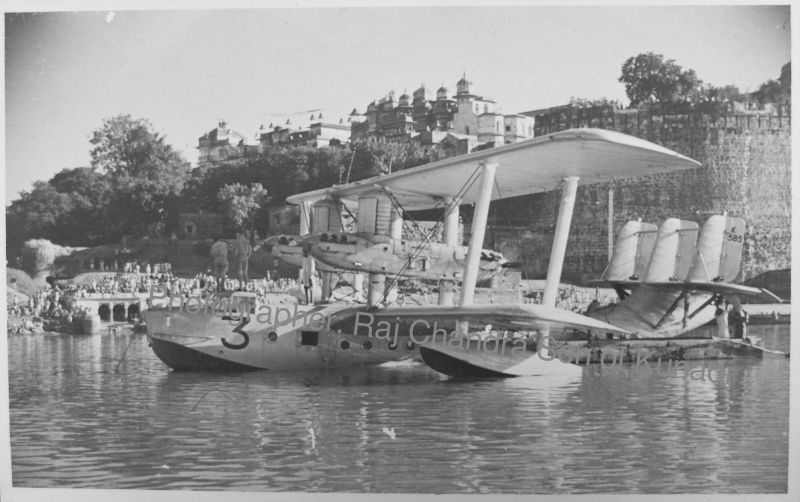
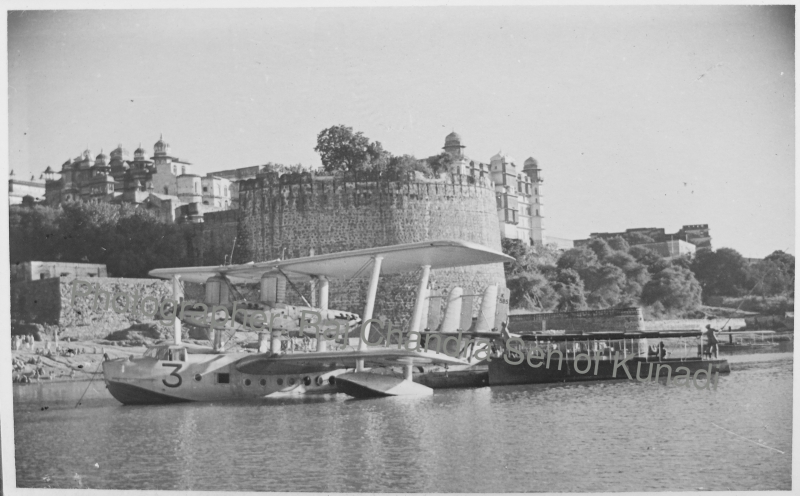
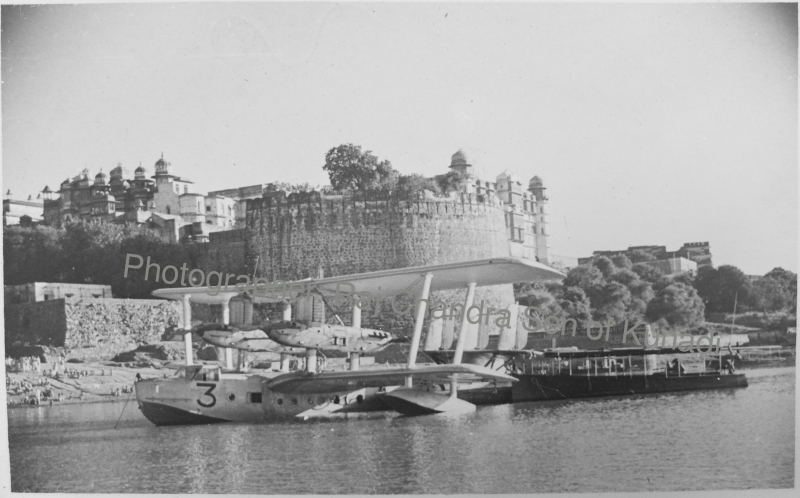
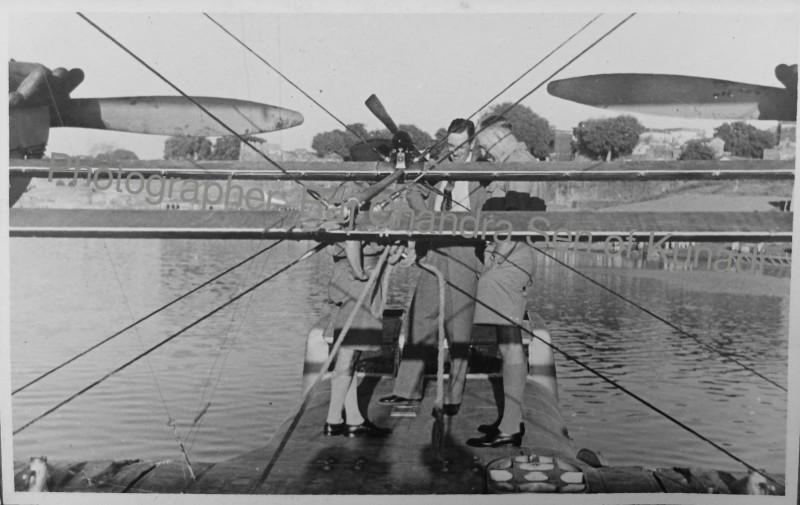
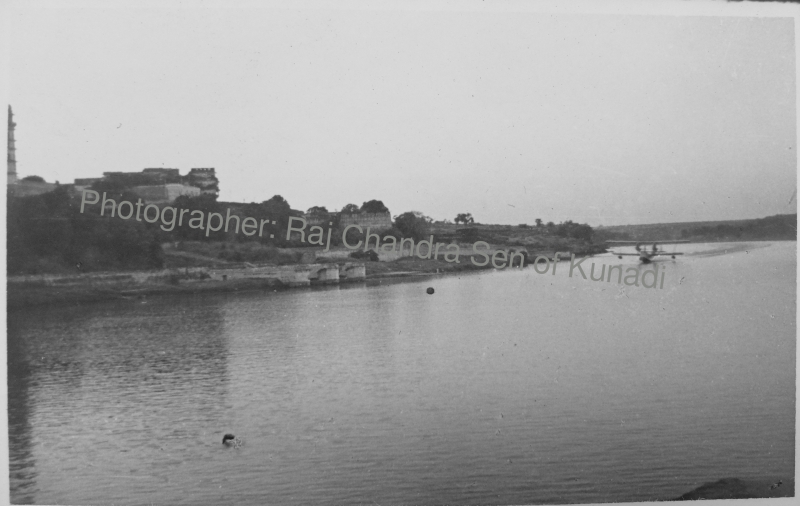
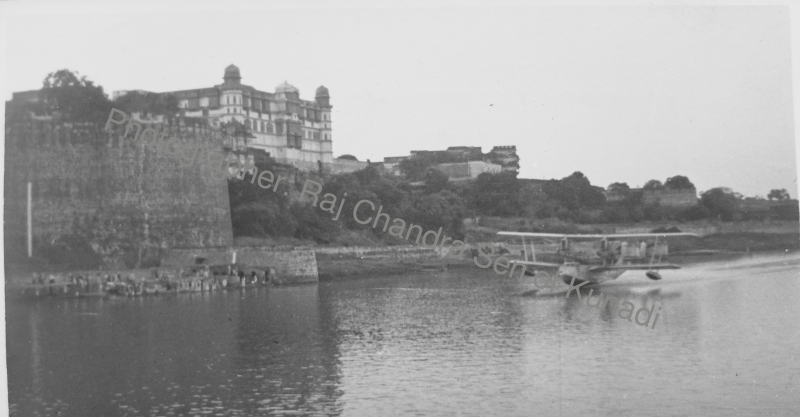
Technical Data: Four in-line engines (two tandem pairs); unequal span, braced biplane; two-step metal hull; three fins and rudders; fixed wing floats. Powered by 800 h.p. Rolls-Royce Kestrel engines. Performance: Top speed 136 knots, cruising 104 knots, range 760 miles, initial climb 770 ft./min., service ceiling 16000 ft. Weight empty 18,776 lbs., loaded 27900 lbs. Crew of 6. (Information courtesy ‘British Aircraft Vol. 2’ by R.A. Saville-Sneath.) 37 were made between 1934 and 1937.
Hastings Bridge at Borkhandi near Kota
If you go eastwards from Kota on NH 27 towards Baran, at Borkhandi, soon after you cross the Kota Bypass, the road crosses the Alnia river which is a tributary of the Chambal. Down below the modern bridge, is the old bridge built in 1818 AD and known as Hastings Bridge.
The original commemoration plaques were damaged and were replaced in the 1990’s, it is said, by the Public Works Department of Kota at the request of Thakur Jaswant Singhji of Sukhdham and Dr. Jagat Narayan. The marble inscriptions in Urdu, Hindi and English state that the bridge was built by Lt. Col. James Tod Political Agent from ‘proceeds of plunder taken from the Pindaris’ by a combined force of British and Kotah troops. (Contradictorily, in a contemporary pen and ink drawing by Capt. Waugh done in c.1818, the credit for building the bridge is given to Zalim Singh Jhala. Is that the clinching proof?)
The Pindaris were mounted mercenaries who had fought for the Marathas and who were raiding Central India reducing the countryside to a desert as the farmers couldn’t grow their crops in peace. After their defeat, one leader, Amir Khan, was settled in the Principality of Tonk and became the Nawab. Another Pindari chieftain known as Chithu was eaten by a tiger as he wandered through the jungle on the banks of the Tapti River.
The Marquis of Hastings (no relation to Warren Hastings) was the Governor General of British India from 1813-1823 and led the campaign against the Pindaris as well as overseeing the alliances with the Rajput states. The first alliance in December 1817 had been between the Maharao of Kotah, Umed Singh I, but negotiated by the Regent Zalim Singh Jhala. (Two further clauses were added in March 1818 and guaranteed the post of Diwan to Zalim Singh and his heirs in perpetuity. This ultimately led to the break up of Kotah state and the formation of Jhalawar in 1838 under the rule of Zalim Singh’s grandson, Madan Singh.)
The bridge was thus dedicated to the Marquis of Hastings and became known as the Hastings Bridge A pen and ink drawing by Capt. Patrick Young Waugh done c.1818 is included in Tod’s Annals and Antiquities of Rajasthan first published in 1829. It shows a royal procession with elephants and camels crossing the bridge while on the near bank some cavalrymen wait.
It is still possible to walk down from the bridge as the design includes steps which are still usable or you can walk through the fields to get a good view of the entire 19 arches. This was the only stone bridge in existence in the state when Umed Singh II came to the throne in 1890. In 1909 he built the first stone bridge in Kotah to cross the River Chambal to replace a toll bridge of boats. It is the low bridge still in use below the main bridge in Nayapura.


